|
Downtown
San Diego Neighborhoods/Districts
|
|
Back to Main Menu
|
Columbia
|
Core |
Cortez
Hill |
East
Village |
Gaslamp Quarter |
Horton Plaza |
Little
Italy |
Marina
| Map |
|
For more information
read the
Downtown Community Plan (40 pages) |
|
Columbia |
 The Columbia neighborhood encompasses
the area between the waterfront and Union, Ash and F
streets. Broadway, downtown's main street, begins at the
Broadway Pier and runs through the center of this
neighborhood. Primarily a commercial neighborhood, there
are also several residential buildings. Columbia is home
to the
San Diego Museum of
Contemporary Art, the
Federal and
County
courthouses, and the
State Office Building,
County Administration Building, the
Historic Santa Fe Train Depot,
the
Cruise Ship Terminals,
the
Embarcadero Promenade,
the
USS Midway and the
Maritime Museum of San Diego. The Columbia neighborhood encompasses
the area between the waterfront and Union, Ash and F
streets. Broadway, downtown's main street, begins at the
Broadway Pier and runs through the center of this
neighborhood. Primarily a commercial neighborhood, there
are also several residential buildings. Columbia is home
to the
San Diego Museum of
Contemporary Art, the
Federal and
County
courthouses, and the
State Office Building,
County Administration Building, the
Historic Santa Fe Train Depot,
the
Cruise Ship Terminals,
the
Embarcadero Promenade,
the
USS Midway and the
Maritime Museum of San Diego.This region was formed from the
bordering portions of two former neighborhoods: one
zoned for commercial use, and the other for recreation.
Previously, the Core, Columbia and Horton Plaza
neighborhoods all comprised the Central Core district,
whose plan emphasized the "highest level intensity
governmental, commercial, office and residential
development," according to the 1992
Centre City
Community Plan. Over a decade later, this vision holds
true in Columbia.
 The waterfront in this neighborhood
is a significant portion of the
North Embarcadero Visionary
Plan, which includes development of, and
along a 100-foot wide boardwalk to provide
entertainment, dining, shopping, and increased access to
the natural beauty of the area. More than $50 million is
designated for public amenities in the project, meant to
facilitate enjoyment of the natural environment, rather
than to substitute a commercial one. The "water first"
strategy is fundamental to the Visionary Plan, which
also includes restructured piers and new activity
centers. The waterfront in this neighborhood
is a significant portion of the
North Embarcadero Visionary
Plan, which includes development of, and
along a 100-foot wide boardwalk to provide
entertainment, dining, shopping, and increased access to
the natural beauty of the area. More than $50 million is
designated for public amenities in the project, meant to
facilitate enjoyment of the natural environment, rather
than to substitute a commercial one. The "water first"
strategy is fundamental to the Visionary Plan, which
also includes restructured piers and new activity
centers.
Back to Top |
Close Window
|
|
Core (Civic Center) |
 Downtown's Core neighborhood stretches
from A Street to Broadway and Union to 12th Avenue. The
Core is the visual and physical center of downtown.
Alonzo Horton
began hotel and retail developments here in the 1860s
and in the 1920s saw the addition of several grand
theatres. The Core was downtown's fashionable business
and entertainment quarter until the urban center's
decline began in the 1960s. Since the
Centre City Development
Corporation's inception in 1975,
development of the Core has been a crucial element to
revitalizing San Diego's downtown area. Many old
buildings have been renovated for new residential and
commercial uses, drawing people into the neighborhood to
live and work. Downtown's Core neighborhood stretches
from A Street to Broadway and Union to 12th Avenue. The
Core is the visual and physical center of downtown.
Alonzo Horton
began hotel and retail developments here in the 1860s
and in the 1920s saw the addition of several grand
theatres. The Core was downtown's fashionable business
and entertainment quarter until the urban center's
decline began in the 1960s. Since the
Centre City Development
Corporation's inception in 1975,
development of the Core has been a crucial element to
revitalizing San Diego's downtown area. Many old
buildings have been renovated for new residential and
commercial uses, drawing people into the neighborhood to
live and work.
This Core now serves as the San
Diego region's government and corporate hub, housing the
Civic Center,
City Hall,
San Diego Housing Federation,
and the
Small Business Administration.
Broadway and C Street are focal areas for daytime and
nighttime activities fostered by street-level merchants.
Notable historic structures in the Core on Broadway include
the Sofia (formerly the Pickwick), the Marriott
(formerly
San Diego Trust & Savings) and
U.S. Grant
hotels.
[see also
Thomas Wolcott Sefton &
SOHO)
  Other notable structures include the
elegant
Westgate Hotel, City Administration Building complex,
Community Concourse,
Civic Theatre & the
new US Court House,
trolley stops along C Street, and the high-rise offices
of the B Street "Financial Corridor" including
Symphony Hall (originally the Fox Theater). Other notable structures include the
elegant
Westgate Hotel, City Administration Building complex,
Community Concourse,
Civic Theatre & the
new US Court House,
trolley stops along C Street, and the high-rise offices
of the B Street "Financial Corridor" including
Symphony Hall (originally the Fox Theater).
Back to Top |
Close Window
|
|
Cortez Hill |
 Named after the historic
El Cortez Hotel,
this neighborhood is one of San Diego's oldest
and most distinguished residential
neighborhoods. North of downtown's Core and
south of I-5 between Tenth Avenue and Union
Street, the 111- acre Cortez Hill is two
neighborhoods in one. East of Sixth Avenue rises
downtown's highest land mass, the hill dominated
by the El Cortez Apartments (formerly
El Cortez Hotel).
West of Sixth Avenue the flatter area is known
as Cortez West. The hill has drawn residents for
over a century, and the original Victorian style
dwellings of the first settlers have now become
part of its charm. Named after the historic
El Cortez Hotel,
this neighborhood is one of San Diego's oldest
and most distinguished residential
neighborhoods. North of downtown's Core and
south of I-5 between Tenth Avenue and Union
Street, the 111- acre Cortez Hill is two
neighborhoods in one. East of Sixth Avenue rises
downtown's highest land mass, the hill dominated
by the El Cortez Apartments (formerly
El Cortez Hotel).
West of Sixth Avenue the flatter area is known
as Cortez West. The hill has drawn residents for
over a century, and the original Victorian style
dwellings of the first settlers have now become
part of its charm.
 In 1992, the Redevelopment
Agency envisioned reviving this district by
further developing the hill for residential use,
and encouraging a mix of residential and
commercial infill. Schools, churches and a
pedestrian-friendly environment now characterize
the western portion of Cortez Hill. Commercial
shops and sidewalk cafes line Fifth and Sixth
Avenues, and Ash Street provides a gateway to
the waterfront. As the highest land mass in the
Centre City Community Planning area, Cortez Hill
boasts views of urban San Diego, Balboa Park,
the bay and Pacific Ocean. The intimate
neighborhood feeling, diverse housing, proximity
to the downtown core and Balboa Park, and
waterfront and mountain views make Cortez Hill a
desirable location. A notable feature of Cortez
Hill is
Tweet Street Park. In 1992, the Redevelopment
Agency envisioned reviving this district by
further developing the hill for residential use,
and encouraging a mix of residential and
commercial infill. Schools, churches and a
pedestrian-friendly environment now characterize
the western portion of Cortez Hill. Commercial
shops and sidewalk cafes line Fifth and Sixth
Avenues, and Ash Street provides a gateway to
the waterfront. As the highest land mass in the
Centre City Community Planning area, Cortez Hill
boasts views of urban San Diego, Balboa Park,
the bay and Pacific Ocean. The intimate
neighborhood feeling, diverse housing, proximity
to the downtown core and Balboa Park, and
waterfront and mountain views make Cortez Hill a
desirable location. A notable feature of Cortez
Hill is
Tweet Street Park.
Back to Top |
Close Window
|
|
East Village |
 Boosted
by plans surrounding
Petco Park,
development skyrocketed in this neighborhood, the last
to be developed by the city. Projects include:
Park at the Park,
a picnic area and neighborhood park; East Village
Square, a 500,000 square foot retail, entertainment and
office development north of the ballpark; Campus at the
Park, space for technology and office buildings on Park
Boulevard; and the Park to Bay Link, a tree-lined
promenade linking Balboa Park and San Diego Bay along
Twelfth Avenue. Boosted
by plans surrounding
Petco Park,
development skyrocketed in this neighborhood, the last
to be developed by the city. Projects include:
Park at the Park,
a picnic area and neighborhood park; East Village
Square, a 500,000 square foot retail, entertainment and
office development north of the ballpark; Campus at the
Park, space for technology and office buildings on Park
Boulevard; and the Park to Bay Link, a tree-lined
promenade linking Balboa Park and San Diego Bay along
Twelfth Avenue.
East Village is San Diego's largest
Downtown neighborhood. Schools, a central police
station, commercial services and industry balance the
residential land use. This center of modern urban
development is also San Diego's arts district, spotted
with artists' homes, studios, galleries and shops. The
Redevelopment Agency has focused on giving East Village
residents "an enviable quality of life" through
beautification, rehabilitation, employment
opportunities, and the development of East Village as an
arts and entertainment center.
 East Village had suffered from
deterioration, crime and homelessness before the Centre
City Community Plan was implemented in 1992. Vast public
improvements, social services, and commercial and
residential developments have made over East Village,
with an emphasis on its rich culture. Now, former
warehouses and other old buildings have been transformed
into charming residential lofts. The
New School of Architecture,
San Diego City College
and two high schools augment this neighborhood's
youthful, creative population. East Village had suffered from
deterioration, crime and homelessness before the Centre
City Community Plan was implemented in 1992. Vast public
improvements, social services, and commercial and
residential developments have made over East Village,
with an emphasis on its rich culture. Now, former
warehouses and other old buildings have been transformed
into charming residential lofts. The
New School of Architecture,
San Diego City College
and two high schools augment this neighborhood's
youthful, creative population.
The
East Village has a rich African-American heritage and
the
Black Historical Society of San Diego & Museum is located
here.
See
Harlem of the West & a
History of African-Americans in Downtown San Diego 1860
- 1960
Back to Top |
Close Window
|
|
Gaslamp Quarter |
 San Diego's Historic
Gaslamp Quarter has become one of
San Diego's most popular neighborhoods,
featuring a charming blend of old and new
building teeming with activity. In the 1870s
Alonzo Horton built a wharf at the foot of Fifth
Avenue and a development boom ensued. San Diego's Historic
Gaslamp Quarter has become one of
San Diego's most popular neighborhoods,
featuring a charming blend of old and new
building teeming with activity. In the 1870s
Alonzo Horton built a wharf at the foot of Fifth
Avenue and a development boom ensued.
 Although
these days a wide variety of people enjoy the
Gaslamp's bars and restaurants, the original
visitors of the 1880s were gamblers and
prostitutes, such as
Wyatt Earp and Ida
Bailey, who founded numerous
gambling halls, saloons and brothels in San
Diego's red light district, the
Stingaree.
see the
Wyatt Earp
On-line Museum.
San Diego remained a popular navy liberty port
until 1912 when city officials cracked down on
prostitution, effectively shutting down the
lively Stingaree. Although
these days a wide variety of people enjoy the
Gaslamp's bars and restaurants, the original
visitors of the 1880s were gamblers and
prostitutes, such as
Wyatt Earp and Ida
Bailey, who founded numerous
gambling halls, saloons and brothels in San
Diego's red light district, the
Stingaree.
see the
Wyatt Earp
On-line Museum.
San Diego remained a popular navy liberty port
until 1912 when city officials cracked down on
prostitution, effectively shutting down the
lively Stingaree.
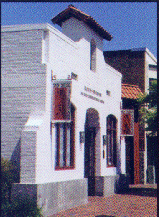 In 1885, the
Chinese Mission School
opened; it quickly became a social center for
Chinese and Japanese immigrants and facilitated
interaction between Caucasian and Asian San
Diegans. Today the Gaslamp's unique architecture
stands as a testament to its 30-year heyday,
between the years 1880 and 1910. Through the
1900s, the Gaslamp Quarter suffered economic and
social decline, as the old buildings
deteriorated and criminal activity mounted. In 1885, the
Chinese Mission School
opened; it quickly became a social center for
Chinese and Japanese immigrants and facilitated
interaction between Caucasian and Asian San
Diegans. Today the Gaslamp's unique architecture
stands as a testament to its 30-year heyday,
between the years 1880 and 1910. Through the
1900s, the Gaslamp Quarter suffered economic and
social decline, as the old buildings
deteriorated and criminal activity mounted.
In an effort to combat
social blight, the Redevelopment Agency drew
upon the historic character of the Gaslamp
Quarter to infuse it with new life. Their
objective formed in 1976 was to "preserve the
distinctive character of the original commercial
architecture found in the Gaslamp Quarter while
also providing for orderly change." The success
of Horton Plaza, opened in 1985, helped
stimulate the initial redevelopment activity
within the Gaslamp Quarter. This 16.5-block
neighborhood is now recognized on the National
Register of Historic Places, and its 94
historically or architecturally significant
structures now house more than 70 restaurants
and nightclubs, movie theaters, shops, offices,
galleries and lofts. Annual events such as the
Mardi Gras Celebration, ShamRock, Taste of
Gaslamp, and Cinco in the Gaslamp are held in
this district, to the delight of San Diego area
residents and visitors. The Gaslamp Quarter is
also home to the little known
Philippine Library &
Museum.
Asian
Pacific Thematic District
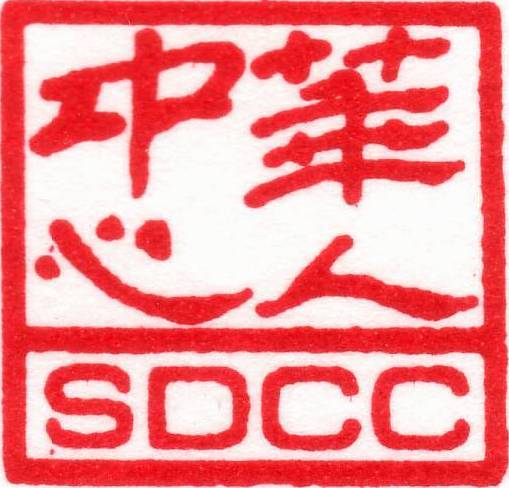 The
Asian Pacific Thematic
District also has a
significant history in the Gaslamp Quarter and
the Marina Neighborhood, and several Asian-style
buildings still stand. Visit the
San Diego Chinese
Historical Museum & the
San Diego Chinese
Center. The
Asian Pacific Thematic
District also has a
significant history in the Gaslamp Quarter and
the Marina Neighborhood, and several Asian-style
buildings still stand. Visit the
San Diego Chinese
Historical Museum & the
San Diego Chinese
Center.
see:
http://www.asianpacificdistrict.org
Back to Top |
Close Window
|
|
|
Horton Plaza |
 When he arrived in 1867,
Alonzo Erastus Horton was not the first to be
attracted by San Diego's natural beauty, but as
the historical father of contemporary San Diego,
he was certainly the most influential. Horton
bought and sold or developed most of the land
that is now downtown San Diego. When he arrived in 1867,
Alonzo Erastus Horton was not the first to be
attracted by San Diego's natural beauty, but as
the historical father of contemporary San Diego,
he was certainly the most influential. Horton
bought and sold or developed most of the land
that is now downtown San Diego.
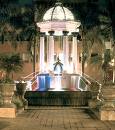 Named after his
namesake
Horton Plaza Park,
which houses the Horton Park Fountain and is
near the bronze statue of the man himself, this
neighborhood is where the redefining of Downtown
began. The
Horton Plaza
Redevelopment Project was adopted
in 1972 to spearhead the transformation of
downtown from the center out. The first
development was the six and one-half-block
Horton Plaza retail/entertainment center, which
ingenuously houses over 140 shops and
restaurants in a colorful labyrinth connecting
seven open-air split levels. This shopping
center is now a local landmark and a tribute to
the creativity and history of San Diego.
High-rise luxury condominiums and mixed-use
residential and retail developments followed. Named after his
namesake
Horton Plaza Park,
which houses the Horton Park Fountain and is
near the bronze statue of the man himself, this
neighborhood is where the redefining of Downtown
began. The
Horton Plaza
Redevelopment Project was adopted
in 1972 to spearhead the transformation of
downtown from the center out. The first
development was the six and one-half-block
Horton Plaza retail/entertainment center, which
ingenuously houses over 140 shops and
restaurants in a colorful labyrinth connecting
seven open-air split levels. This shopping
center is now a local landmark and a tribute to
the creativity and history of San Diego.
High-rise luxury condominiums and mixed-use
residential and retail developments followed.
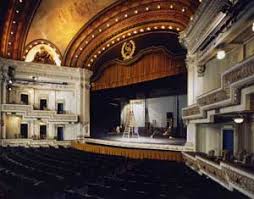 Today, the Horton Plaza neighborhood includes a
Westin Hotel,
the Meridian condominium tower,
Horton Fourth Avenue
apartments, the AT&T and
NBC
office towers,
Federal Courthouse & Office
building and the
historic
Spreckels
and
Balboa
theaters.
More on the Spreckels. See
Theater History in San Diego. Today, the Horton Plaza neighborhood includes a
Westin Hotel,
the Meridian condominium tower,
Horton Fourth Avenue
apartments, the AT&T and
NBC
office towers,
Federal Courthouse & Office
building and the
historic
Spreckels
and
Balboa
theaters.
More on the Spreckels. See
Theater History in San Diego.Residential opportunities
may be limited, but this 15-block district puts
residents at the center of Downtown's activity.
The area includes luxury condominiums and
apartments amidst high-rise office buildings,
retail, hotels, theaters and restaurants.
See:
http://www.nbcsandiego.com/news/local/Makeover-Looming-at-Horton-Plaza-Park.html
http://www.sandiegohistory.org/journal/74fall/hortonplaza.htm
Back to Top |
Close Window
|
|
|
|
|
Little Italy |
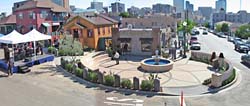 The sloping landscape at the northern
shore of San Diego Bay was once home to a thriving tuna
fishing industry and the Italian-Americans who derived
their livelihood from it. As the tuna industry declined
and a significant portion of the neighborhood was
disrupted by the construction of Interstate 5,
Little Italy
suffered decades of depreciation. When local business
owners and residents teamed up with the Centre City
Development Corporation in the early 1990s, things
started looking up. They envisioned revitalization of
the commercial district and preservation of the small
scale and cultural dynamic of the community. The sloping landscape at the northern
shore of San Diego Bay was once home to a thriving tuna
fishing industry and the Italian-Americans who derived
their livelihood from it. As the tuna industry declined
and a significant portion of the neighborhood was
disrupted by the construction of Interstate 5,
Little Italy
suffered decades of depreciation. When local business
owners and residents teamed up with the Centre City
Development Corporation in the early 1990s, things
started looking up. They envisioned revitalization of
the commercial district and preservation of the small
scale and cultural dynamic of the community.
Little Italy
today represents some of the finest of San Diego living:
bay views, fine food, art and cultural festivities, and
affordable residences. Its lovely vistas now offer an
urban neighborhood with single-family homes,
condominiums and apartments. A recently revitalized
India Street is alive with restaurants, small cafes,
galleries and specialty shops.
 Our Lady of the Rosary Church
,
Monarch School
and
Washington Elementary School
remain important institutions of the area.
Amici Park
serves both as a playground for the school and a park,
including a bocce ball court, for the community. There
is the
Firehouse Museum
(located on Columbia St). Little Italy hosts over
half-a-dozen annual festivals in celebration of
holidays, music and art, including Festa, "Chalk La
Strada," a Bocce Ball Tournament, ArtWalk, a jazz
festival and Cinco de Mayo, St. Patrick's Day, and
Easter celebrations. The
Little Italy Association
(LIA)
brings the story of Little Italy to its visitors through
public art displays. The
Little
Italy Residents Association (LIRA)
is dedicated to helping
residents of the downtown San Diego neighborhood of
Little Italy. With many new families relocating to
downtown, we offer the opportunity through our
organization for residents to get involved with local
events, give input on new civic projects, and best of
all, to meet their neighbors. Little Italy in San
Diego is a designated "Preserve
America Community" Our Lady of the Rosary Church
,
Monarch School
and
Washington Elementary School
remain important institutions of the area.
Amici Park
serves both as a playground for the school and a park,
including a bocce ball court, for the community. There
is the
Firehouse Museum
(located on Columbia St). Little Italy hosts over
half-a-dozen annual festivals in celebration of
holidays, music and art, including Festa, "Chalk La
Strada," a Bocce Ball Tournament, ArtWalk, a jazz
festival and Cinco de Mayo, St. Patrick's Day, and
Easter celebrations. The
Little Italy Association
(LIA)
brings the story of Little Italy to its visitors through
public art displays. The
Little
Italy Residents Association (LIRA)
is dedicated to helping
residents of the downtown San Diego neighborhood of
Little Italy. With many new families relocating to
downtown, we offer the opportunity through our
organization for residents to get involved with local
events, give input on new civic projects, and best of
all, to meet their neighbors. Little Italy in San
Diego is a designated "Preserve
America Community"
More on
Little Italy.
Back to Top |
Close Window
|
|
Marina |
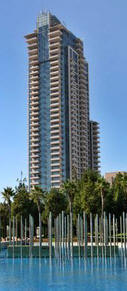 Bordered by the Gaslamp Quarter and the
Columbia neighborhood, the Marina neighborhood was once
comprised of warehouses and vacant lots. Through
redevelopment, beginning in the early 1980s, the Marina now
offers high-rise and mid-rise condominiums and apartments,
townhouses, loft and single-room-occupancy (SRO) units, in a
variety of styles, sizes and prices. Marina, characterized
by open space, educational and cultural sites, and its
convenient locale, is a remarkable residential setting for
families, professionals and retirees. Bordered by the Gaslamp Quarter and the
Columbia neighborhood, the Marina neighborhood was once
comprised of warehouses and vacant lots. Through
redevelopment, beginning in the early 1980s, the Marina now
offers high-rise and mid-rise condominiums and apartments,
townhouses, loft and single-room-occupancy (SRO) units, in a
variety of styles, sizes and prices. Marina, characterized
by open space, educational and cultural sites, and its
convenient locale, is a remarkable residential setting for
families, professionals and retirees.
 Attractions of this neighborhood include the
Greatest Generation Art Collection,
Martin L. King, Jr. Promenade,
the
Urban Forest
(aka Children's Park) with a reflecting pond and
fountain, historic
Pantoja Park, the
Children's Museum
&
Playground Park, a portion of the
Asian Pacific Thematic Historic District and two trolley stops. Its
proximity to San Diego Bay, the
Embarcadero Marina Park North,
the waterfront promenade,
Seaport Village, the
San Diego Convention Center and waterfront hotels make the
Marina a dynamic center for entertainment and business. Attractions of this neighborhood include the
Greatest Generation Art Collection,
Martin L. King, Jr. Promenade,
the
Urban Forest
(aka Children's Park) with a reflecting pond and
fountain, historic
Pantoja Park, the
Children's Museum
&
Playground Park, a portion of the
Asian Pacific Thematic Historic District and two trolley stops. Its
proximity to San Diego Bay, the
Embarcadero Marina Park North,
the waterfront promenade,
Seaport Village, the
San Diego Convention Center and waterfront hotels make the
Marina a dynamic center for entertainment and business.
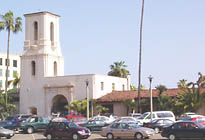 Marina neighborhood was once home to
the
Olde Cracker Factory
and the
Citrus Soap Factory
(both of which have been converted into work lofts and
residential condos). Favorite neighborhood hangouts include The
Brickyard Coffee Shop, so named for the Brickyard Company
that once occupied the area and the
Kansas City Barbecue
(made famous by Top Gun). Another historic building in the
Marina Neighborhood is the
Old San Diego Police Headquarters
. Marina neighborhood was once home to
the
Olde Cracker Factory
and the
Citrus Soap Factory
(both of which have been converted into work lofts and
residential condos). Favorite neighborhood hangouts include The
Brickyard Coffee Shop, so named for the Brickyard Company
that once occupied the area and the
Kansas City Barbecue
(made famous by Top Gun). Another historic building in the
Marina Neighborhood is the
Old San Diego Police Headquarters
.
The Marina District is one of the older
and more established Downtown San Diego Neighborhoods.
Back to Top |
Close
Window
|
 The Columbia neighborhood encompasses
the area between the waterfront and Union, Ash and F
streets. Broadway, downtown's main street, begins at the
Broadway Pier and runs through the center of this
neighborhood. Primarily a commercial neighborhood, there
are also several residential buildings. Columbia is home
to the
San Diego Museum of
Contemporary Art, the
Federal and
County
courthouses, and the
State Office Building,
County Administration Building, the
Historic Santa Fe Train Depot,
the
Cruise Ship Terminals,
the
Embarcadero Promenade,
the
USS Midway and the
Maritime Museum of San Diego.
The Columbia neighborhood encompasses
the area between the waterfront and Union, Ash and F
streets. Broadway, downtown's main street, begins at the
Broadway Pier and runs through the center of this
neighborhood. Primarily a commercial neighborhood, there
are also several residential buildings. Columbia is home
to the
San Diego Museum of
Contemporary Art, the
Federal and
County
courthouses, and the
State Office Building,
County Administration Building, the
Historic Santa Fe Train Depot,
the
Cruise Ship Terminals,
the
Embarcadero Promenade,
the
USS Midway and the
Maritime Museum of San Diego. Downtown's Core neighborhood stretches
from A Street to Broadway and Union to 12th Avenue. The
Core is the visual and physical center of downtown.
Alonzo Horton
began hotel and retail developments here in the 1860s
and in the 1920s saw the addition of several grand
theatres. The Core was downtown's fashionable business
and entertainment quarter until the urban center's
decline began in the 1960s. Since the
Centre City Development
Corporation's inception in 1975,
development of the Core has been a crucial element to
revitalizing San Diego's downtown area. Many old
buildings have been renovated for new residential and
commercial uses, drawing people into the neighborhood to
live and work.
Downtown's Core neighborhood stretches
from A Street to Broadway and Union to 12th Avenue. The
Core is the visual and physical center of downtown.
Alonzo Horton
began hotel and retail developments here in the 1860s
and in the 1920s saw the addition of several grand
theatres. The Core was downtown's fashionable business
and entertainment quarter until the urban center's
decline began in the 1960s. Since the
Centre City Development
Corporation's inception in 1975,
development of the Core has been a crucial element to
revitalizing San Diego's downtown area. Many old
buildings have been renovated for new residential and
commercial uses, drawing people into the neighborhood to
live and work.
 Named after the historic
El Cortez Hotel,
this neighborhood is one of San Diego's oldest
and most distinguished residential
neighborhoods. North of downtown's Core and
south of I-5 between Tenth Avenue and Union
Street, the 111- acre Cortez Hill is two
neighborhoods in one. East of Sixth Avenue rises
downtown's highest land mass, the hill dominated
by the El Cortez Apartments (formerly
El Cortez Hotel).
West of Sixth Avenue the flatter area is known
as Cortez West. The hill has drawn residents for
over a century, and the original Victorian style
dwellings of the first settlers have now become
part of its charm.
Named after the historic
El Cortez Hotel,
this neighborhood is one of San Diego's oldest
and most distinguished residential
neighborhoods. North of downtown's Core and
south of I-5 between Tenth Avenue and Union
Street, the 111- acre Cortez Hill is two
neighborhoods in one. East of Sixth Avenue rises
downtown's highest land mass, the hill dominated
by the El Cortez Apartments (formerly
El Cortez Hotel).
West of Sixth Avenue the flatter area is known
as Cortez West. The hill has drawn residents for
over a century, and the original Victorian style
dwellings of the first settlers have now become
part of its charm.
 The sloping landscape at the northern
shore of San Diego Bay was once home to a thriving tuna
fishing industry and the Italian-Americans who derived
their livelihood from it. As the tuna industry declined
and a significant portion of the neighborhood was
disrupted by the construction of Interstate 5,
Little Italy
suffered decades of depreciation. When local business
owners and residents teamed up with the Centre City
Development Corporation in the early 1990s, things
started looking up. They envisioned revitalization of
the commercial district and preservation of the small
scale and cultural dynamic of the community.
The sloping landscape at the northern
shore of San Diego Bay was once home to a thriving tuna
fishing industry and the Italian-Americans who derived
their livelihood from it. As the tuna industry declined
and a significant portion of the neighborhood was
disrupted by the construction of Interstate 5,
Little Italy
suffered decades of depreciation. When local business
owners and residents teamed up with the Centre City
Development Corporation in the early 1990s, things
started looking up. They envisioned revitalization of
the commercial district and preservation of the small
scale and cultural dynamic of the community.
 Bordered by the Gaslamp Quarter and the
Columbia neighborhood, the Marina neighborhood was once
comprised of warehouses and vacant lots. Through
redevelopment, beginning in the early 1980s, the Marina now
offers high-rise and mid-rise condominiums and apartments,
townhouses, loft and single-room-occupancy (SRO) units, in a
variety of styles, sizes and prices. Marina, characterized
by open space, educational and cultural sites, and its
convenient locale, is a remarkable residential setting for
families, professionals and retirees.
Bordered by the Gaslamp Quarter and the
Columbia neighborhood, the Marina neighborhood was once
comprised of warehouses and vacant lots. Through
redevelopment, beginning in the early 1980s, the Marina now
offers high-rise and mid-rise condominiums and apartments,
townhouses, loft and single-room-occupancy (SRO) units, in a
variety of styles, sizes and prices. Marina, characterized
by open space, educational and cultural sites, and its
convenient locale, is a remarkable residential setting for
families, professionals and retirees.
 Other notable structures include the
elegant
Other notable structures include the
elegant
 In 1992, the Redevelopment
Agency envisioned reviving this district by
further developing the hill for residential use,
and encouraging a mix of residential and
commercial infill. Schools, churches and a
pedestrian-friendly environment now characterize
the western portion of Cortez Hill. Commercial
shops and sidewalk cafes line Fifth and Sixth
Avenues, and Ash Street provides a gateway to
the waterfront. As the highest land mass in the
Centre City Community Planning area, Cortez Hill
boasts views of urban San Diego, Balboa Park,
the bay and Pacific Ocean. The intimate
neighborhood feeling, diverse housing, proximity
to the downtown core and Balboa Park, and
waterfront and mountain views make Cortez Hill a
desirable location. A notable feature of Cortez
Hill is
In 1992, the Redevelopment
Agency envisioned reviving this district by
further developing the hill for residential use,
and encouraging a mix of residential and
commercial infill. Schools, churches and a
pedestrian-friendly environment now characterize
the western portion of Cortez Hill. Commercial
shops and sidewalk cafes line Fifth and Sixth
Avenues, and Ash Street provides a gateway to
the waterfront. As the highest land mass in the
Centre City Community Planning area, Cortez Hill
boasts views of urban San Diego, Balboa Park,
the bay and Pacific Ocean. The intimate
neighborhood feeling, diverse housing, proximity
to the downtown core and Balboa Park, and
waterfront and mountain views make Cortez Hill a
desirable location. A notable feature of Cortez
Hill is
 East Village had suffered from
deterioration, crime and homelessness before the Centre
City Community Plan was implemented in 1992. Vast public
improvements, social services, and commercial and
residential developments have made over East Village,
with an emphasis on its rich culture. Now, former
warehouses and other old buildings have been transformed
into charming residential lofts. The
East Village had suffered from
deterioration, crime and homelessness before the Centre
City Community Plan was implemented in 1992. Vast public
improvements, social services, and commercial and
residential developments have made over East Village,
with an emphasis on its rich culture. Now, former
warehouses and other old buildings have been transformed
into charming residential lofts. The

 Although
these days a wide variety of people enjoy the
Gaslamp's bars and restaurants, the original
visitors of the 1880s were gamblers and
prostitutes, such as
Although
these days a wide variety of people enjoy the
Gaslamp's bars and restaurants, the original
visitors of the 1880s were gamblers and
prostitutes, such as
 In 1885, the
In 1885, the
 The
The
 When he arrived in 1867,
When he arrived in 1867,
 Named after his
namesake
Named after his
namesake


 Attractions of this neighborhood include the
Attractions of this neighborhood include the
